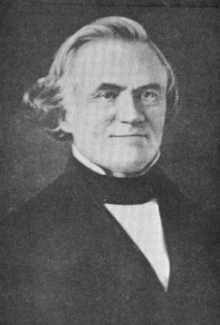Elam Lynds
Captain Elam Lynds (1784–1855) was a prison warden. He helped create the Auburn system, which consisted of congregate labor during the day and isolation at night, starting in 1821 and was Warden of Sing Sing from 1825 to 1830.[1]
Elam Lynds | |
|---|---|
 Lynds circa 1840-1850 | |
| Warden of Auburn Correctional Facility | |
| In office 1821–1825 | |
| Warden of Sing Sing | |
| In office 1825–1830 | |
| Succeeded by | Robert Wiltse |
| Personal details | |
| Born | 1784 Litchfield, Connecticut |
| Died | 1855 (age 71) New York City |
| Children | Cornelia Lynds DeForest |
Early life
Elam Lynds was born in Litchfield, Connecticut in 1784. His parents moved to Troy, New York, when he was an infant. He learned the hatter's trade and worked at it for some years.
War of 1812 service
In the War of 1812 he held a captain's commission in a New York regiment.
Auburn State Prison
The Auburn State Prison's South Wing was opened in the Spring of 1817, and fifty-three prisoners were transferred there from nearby counties.[2] Captain Lynds was made the first principal keeper, and four years afterwards he became Warden of Auburn State Prison.
Lynds devised the main features of what is now known as the Auburn System of imprisonment.[3] When Lynds took charge of the Auburn in 1821, he felt that discipline there was lax, with guards only interested in preventing escape.[4] Lynds concluded that chaining prisoners in a dungeon failed to produce "a good state of discipline" and resorted, exclusively, to beatings.[4] Speaking in 1826 to commissioners directed by the act of 17 April 1826, to visit the State-Prison at Auburn, Lynds said:
After making, as I thought, a fair experiment of [the dungeon], and finding it fail me altogether, I began to use the rod ; and when a [prisoner] would laugh at the dungeon, I could make him perfectly obedient with a few stripes of a cowskin [whip], and a promise that he should have as much more as should be requisite.[4]
In 1821, ordinary citizens took to rioting at Auburn State Prison in New York to protest against the kind of treatment inmates were subjected to.[note 1] The warden of Auburn, Elam Lynds was notoriously brutal and frequently flogged and whipped the prisoners.[5][6][7] Even his own staff objected to his brutal methods.[2] In the Spring of 1821, keepers refused to flog a prisoner.[8][2][9] The keepers were fired and a blacksmith named Jonathan Thompson carried out the flogging.[note 2] When he left the prison, he was tarred and feathered by a crowd. Henry Hall, in The History of Auburn (1861), described the scene this way:
As [Thompson] passed through the prison gate, he was seized by a furious crowd of laborers, tarred from head to foot, and borne through the streets astride a rail. The ring-leader of the mob, with a hen under his arm, walked by the side of the unfortunate Thompson, and plucking handfuls of feathers from the screaming fowl, stuck them to the blacksmith's tarry coat. This shocking affair was condignly punished as a riot. On the other hand, the convicts, stimulated by this outside sympathy, learned to be rebellious, transgressed the rules of the shops at every opportunity, and set fire to the buildings, and destroyed their work, whenever they dared.[2]
Retirement and death
After his retirement from the prison service he lived in New York City, where he died in 1855.[10]
Notes
- Prisoner "mutinies" were a continual source of concern for prison authorities of the period, partly because they worried that prisoners would receive aid and support from those living nearby, and partly because they recognized that prison riots could form the nucleus of a wider popular uprising. For a discussion, see McLennan, Rebecca M. (2008). The Crisis of Imprisonment: Protest, Politics, and the Making of the American Penal State, 1776–1941. Cambridge University Press. p. 44.
- Accounts of the incident vary. According to Hall's (1861) The History of Auburn, the incident began with the refusal of prison keepers to whip "three disobedient convicts." Other sources generally report that three keepers refused to whip one convict. (See Christianson, Scott (2000). With Liberty for Some: 500 Years of Imprisonment in America. University Press of New England. p. 113.) Sources also differ about whether the keepers were fired in succession, with each fired when he refused, and about whether Thompson, the blacksmith, volunteered himself to flog the prisoner(s) and whether or not he was paid to do so.
References
- Annual report of the Board of Managers of the Prison Discipline Society. Prison Discipline Society. 1827.
Mr. Elam Lynds, the author of the Auburn system, and the founder of the establishment at Sing Sing ...
- Hall, Henry (1861). The history of Auburn. Auburn: Dennis Bros. & Co. pp. 132–133.
- de Beaumont, Gustave; de Tocqueville, Alexis (1833). On the Penitentiary System in the United States: And Its Application in France; with an Appendix on Penal Colonies, and Also, Statistical Notes. Carey, Lea & Blanchard.
- "Appendix A, Elam Lynds (testimony, September 12, 1826)". REPORT Of the Commissioners, directed by the act of 17th April, 1826, to visit the State-Prison at Auburn (Report). Journal of the Senate of the State of New York. January 13, 1827. pp. 33, 126. Retrieved January 20, 2018.
- Welch, Michael (2013). Corrections: A Critical Approach. Routledge. p. 63.
- Wolcott, David B.; Head, Tom (2010). Crime and Punishment in America. Infobase. p. 50. ISBN 1438126891.
- Brian, Denis (2015). Sing Sing: The Inside Story of a Notorious Prison. Prometheus Books.
- Lewis, W. David (2009). From Newgate to Dannemora: The Rise of the Penitentiary in New York, 1796-1848. Ithica: Cornell University Press. p. 60.
- Christianson, Scott (2000). With Liberty for Some: 500 Years of Imprisonment in America. University Press of New England. p. 113.
- Charles Richmond Henderson (1910). Correction and prevention.